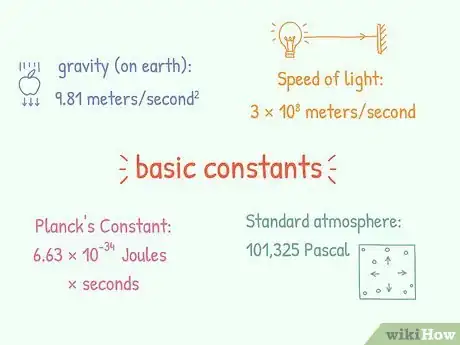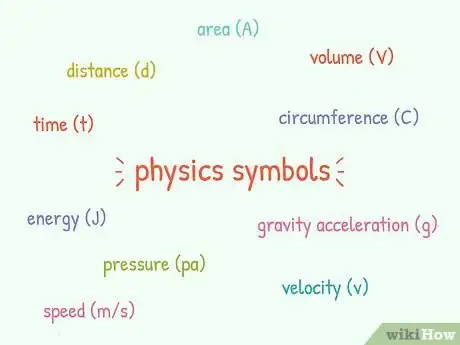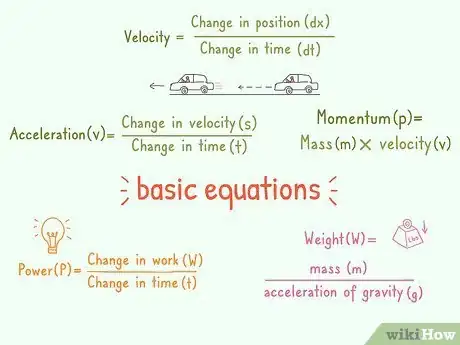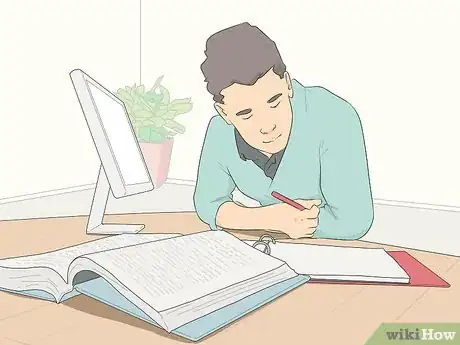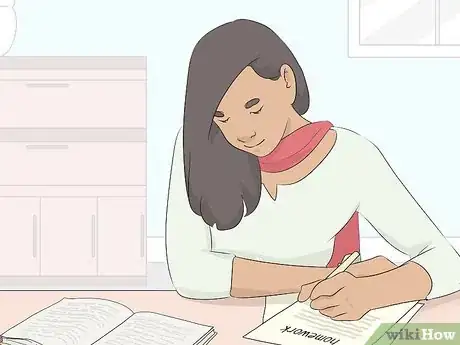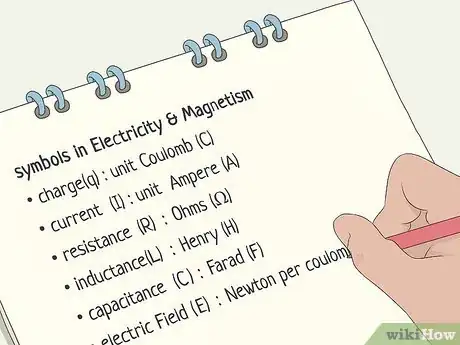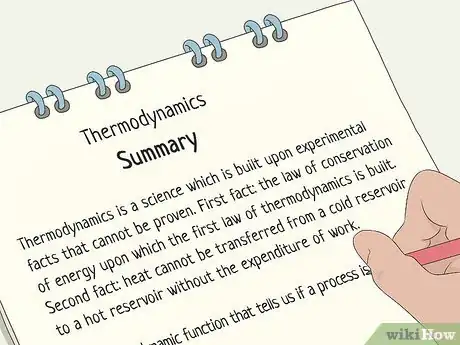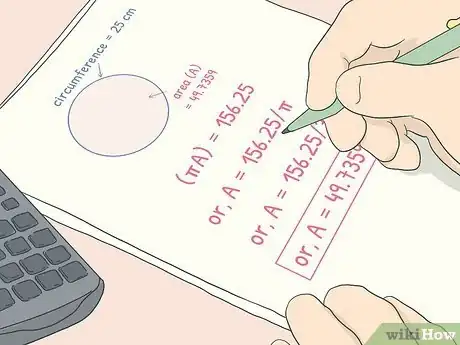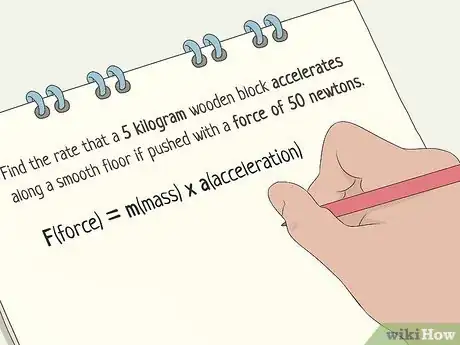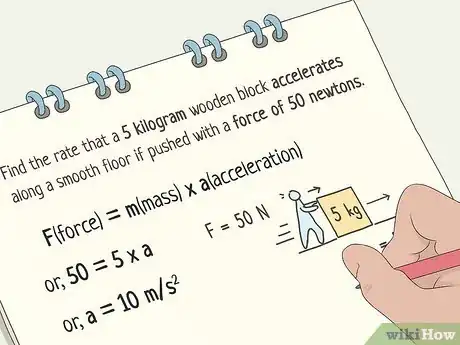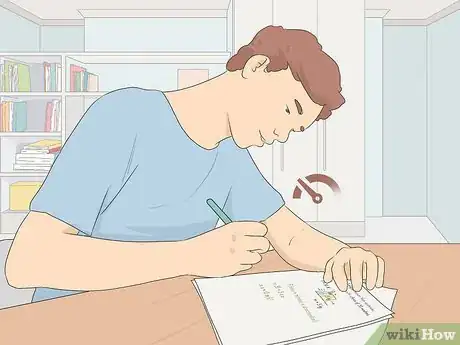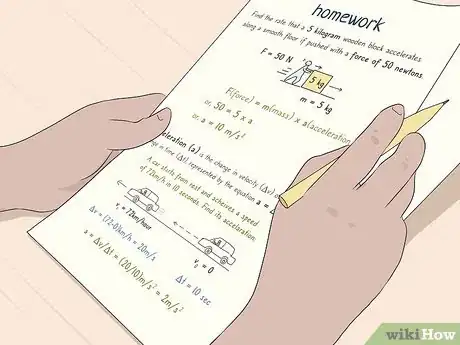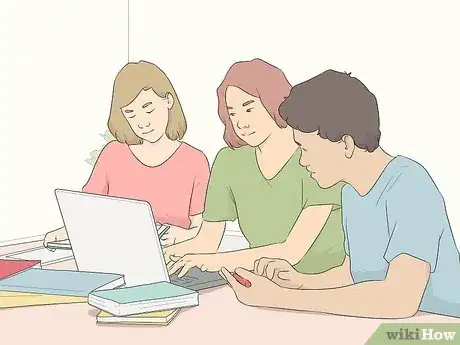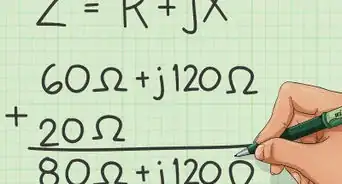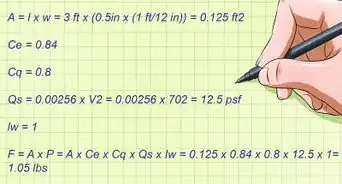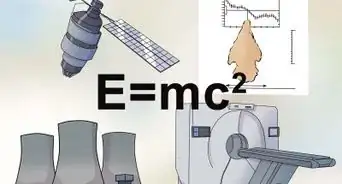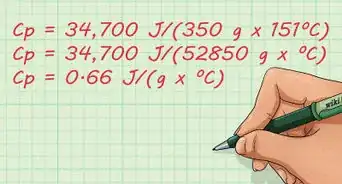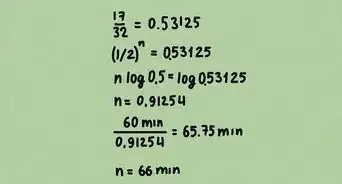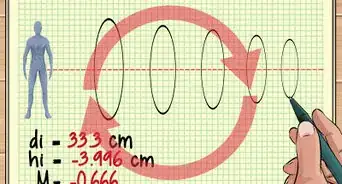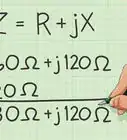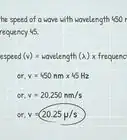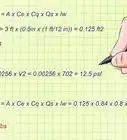This article was co-authored by Sean Alexander, MS. Sean Alexander is an Academic Tutor specializing in teaching mathematics and physics. Sean is the Owner of Alexander Tutoring, an academic tutoring business that provides personalized studying sessions focused on mathematics and physics. With over 15 years of experience, Sean has worked as a physics and math instructor and tutor for Stanford University, San Francisco State University, and Stanbridge Academy. He holds a BS in Physics from the University of California, Santa Barbara and an MS in Theoretical Physics from San Francisco State University.
There are 12 references cited in this article, which can be found at the bottom of the page.
This article has been viewed 12,658 times.
Physics is a tough subject with many different concepts, equations, terms, and symbols. Many students struggle with physics, so don’t worry if you’re having some trouble. Luckily, with some careful work and dedication, you can improve your grades and knowledge. It just takes a bit of extra studying and working on your problem-solving ability to master the subject.
Steps
Revisiting Basic Concepts
-
1Memorize the most common physics constants. In physics, a constant is a value that always remains the same. Acceleration due to gravity of Earth, for instance, is same near to the surface of Earth. Different constants are used in a lot of physics formulas because they represent how the natural world operates. It's best to memorize some of the most common constants because you may not be able to look them up on exams.[1]
- Gravity on Earth (Acceleration due to gravity near Earth's surface): 9.80665 meters/second2
- Speed of light in vacuum (c): 299,792,458 meters/second
- Standard atmosphere: 101,325 Pascal
- Planck's Constant: 6.63 × 10-34 Joules × seconds
-
2Keep track of all the common physics symbols. Physics uses dozens of symbols to represent different values. You'll see a lot of these symbols in equations and formulas, so you'll likely make some mistakes if you don't know the important ones. Keep a list of all the common symbols that you might come across and study it regularly to work out calculations faster.[2]
- Some common symbols are easy to remember, like volume (V), area (A), circumference (C), distance (d), time (t) and gravity acceleration (g).
- Remember to pay attention to capital and lowercase letters because they mean different things. For example, V means volume but v means velocity.
- Different units of measure use symbols as well. Some common ones are J (joule), Pascal (Pa), meters per second (m/s), and radian (rad).
- Note that these symbols don't mean the same thing all the time. They might change depending on the topic.
Advertisement -
3Learn the basic equations that you'll need.[3] Physics also uses many formulas and equations to solve problems. These equations represent how forces interact in the real world. You'll probably use many of the basic ones consistently in any physics class, so it's best to commit them to memory early on. Some of the common ones are:[4]
- Velocity: speed/time ()
- Acceleration: change in velocity/change in time ()
- Weight: mass/acceleration of gravity (W = mg)
- Momentum: mass/velocity (p = mv)
- Power: work/elapsed time (P= W/t)
-
4Study the correct application of each formula or equation. Physics isn’t just about memorizing formulas and plugging the right numbers in. You have to understand how to use those formulas to solve problems. When you study, focus on how to apply each formula in that chapter. Write down the situations that you’d use it in and what problem it solves.[5]
- It’s helpful to dedicate a part of your notebook to formulas. Write down the equation, what each number or symbol represents, and when you’d use it. This way, you’ll have a quick guide to review the formulas.
- Some professors will even give you the formulas you need on a test, or let you bring notes in to remember the formulas. This is because they know that the formulas are useless if you don’t know how to use them.
Studying the Material Effectively
-
1Start studying well ahead of any exams or quizzes. This is a good rule for all subjects, but especially physics. This topic requires a deep understanding of how to use formulas, concepts, and problem-solving skills, so you can’t cram before a test. When you hear about a test, draw up a study schedule. Start at least a week before the exam and do a bit of studying each night. That way, you’ll absorb the information and be well-prepared for the test.[6]
- It’s always good practice to spend an hour studying after each class to ensure you understand the concepts. This will help you learn better and also prepare you for any pop quizzes that might come up.
-
2Do all of your classwork so you don’t miss any important information. Follow your course schedule and do all the necessary readings or problems ahead of class. When the teacher assigns homework, do it all and review it to make sure you haven’t made any mistakes. This prevents you from falling behind in class.[7]
- Physics reading assignments can be pretty dense, so block off enough time to read slowly and carefully. It might take you an hour to read just a few pages. Don’t rush or you’ll get confused.
- Remember to make sure you understand the work as well. Ask your teacher if you didn’t understand a homework question so you know how to solve it properly.
-
3Make a list of terms and symbols that you aren’t familiar with. While you do your class assignments, you’ll probably come across a lot of terms or concepts you aren’t familiar with. Keep a notebook or file of these topics and look them up later. Study this list so you’re prepared for tests.[8]
- Also note if there are certain formulas associated with some terms. For example, in physics, the equation for Force is F = Mass x Acceleration. Write this formula along with the force definition.
- Pay particular attention to any symbols you come across. If you don’t recognize symbols, you could end up getting easy questions wrong.
-
4Give a brief summary of the material you just studied. This is a good way to wrap up a study session. Close all of your study materials and give a 1-minute wrap-up of what you learned. If you can do this easily, then you have a good grasp of the material. If you struggle, then you probably need some more work.[9]
- If you’re in a study group, try summarizing the work to your partners.
- It’s also helpful to try and teach something to a person who doesn’t know anything about it. If you can effectively explain a formula to your roommate or family members, then you have a good understanding of it.
-
5Brush up on your math skills if you’re rusty. Physics involves a lot of math, and teachers will probably assume that you have a grasp of basic math. If you struggle with math as well, then you’ll also struggle with physics. Go back and review some math basics so you’re prepared for solving physics equations. Working through a basic textbook form the library will probably do the trick.[10]
- The most common types of math in physics are algebra, calculus, and geometry. You’ll at least need the basics for these subjects.[11]
- See if your campus has a math club or student tutors. This can be an easy way to brush up on math.
Solving Problems
-
1Read each part of the question so you know what it’s asking. Before solving a problem, you have to understand what it’s asking you to do. Work slowly and read through the entire question. Underline key parts and identify the main point. When you feel confident that you know what the question is asking, then start solving it.[12]
- Sometimes whispering the question out loud to yourself helps you visualize it better.
- Don’t try to start solving the problem before you’ve read and understand it, even if it seems easy. You could miss something important and make a silly mistake.[13]
-
2Name all the concepts that the problem uses. Physics involves a number of concepts, like motion, thermodynamics, force, relativity, and more. Concepts have particular rules and formulas associated with them, so identifying the concept in a problem is a big step towards solving it.[14]
- If you get stuck on a question, try to broadly figure out what the concept it uses it. This helps you work towards a solution.
- For example, you might get stuck on a question, but know that it’s a thermodynamics problem. This narrows down the equations you’ll use to conservation of mass and energy, and heat transfer. This at least gives you a starting point.[15]
-
3Choose the equation that you’ll use to solve the problem. Once you understand the problem and what it’s asking, then you can start working it out. In most cases, you’ll have to use an equation to do this. Determine the correct equation by identifying the question concept, and then insert the correct values to work the equation out.[16]
- There isn’t necessarily only one correct equation to use. The same problem might have several different solutions.
- Remember to solve for the correct value in the problem. If you have to determine the force of an object, then you’re using the equation F = M x A and solving for F.
-
4Draw a picture to help visualize the problem. Some physics problems can be represented visually, so try sketching out a simple picture to envision the problem better. This will help you understand what it’s asking and make solving the problem easier.[17]
- For example, if a question is asking about the force of an object rolling down a hill, sketch an incline and draw a rock at the top. Label the parts and plug in variables to make a visual representation of the problem.
Overcoming Difficulties
-
1Work slowly so you don’t miss important parts of the question. In many cases, you might be struggling with physics because you’re moving too fast. Always read and understand the entire question before you start trying to solve it. This way, you’ll avoid making silly mistakes.[18]
- Read each part of the question first. Then try to break down which concepts it uses, what formula you’d use to work it out, and which numbers get plugged in to each part of the equation.
- It might help to underline key parts of the question as you’re reading it. This keeps you focused so you won’t miss any important information.
- If you’re taking an exam and get stuck on a question, try skipping it and moving on to the next one. That way, you can complete the easier questions without getting bogged down.
- Always check your answer to see if it works in the context of the original problem.[19]
-
2Ask your instructor for help as soon as you’re confused. Your instructor is there to help you, so don’t hesitate to ask for clarification. Ask as soon as you realize you’re confused. If you wait until you’re completely lost, the teacher will have to spend a lot of time getting you caught up. A few good questions can get you back on track quickly.[20]
- Raise your hand in class to ask for more clarification if the instructor teaches something you don’t understand. You’re not interrupting class as long as you ask relevant questions.
- If you’re in college, take advantage of your professor’s office hours to get more clarification.
-
3Analyze your past work and tests to see what questions you got wrong. If you’re having trouble in physics, then you’ve probably already gotten some low grades on tests or class assignments. Go back to these assignments and make a list of all the questions you got wrong. Then work them out on your own time to find the correct answer. This way, you’ll build your knowledge to do better in the future.[21]
- Remember that you need to understand how to get the correct answer, not just the correct answer itself. This trains you to become an effective problem solver.
- There might be a particular type of question that you always get wrong. Note this down and review the relevant material to tackle these questions correctly.
- If you’re still totally lost, bring the exam to your instructor and ask for more explanation. Say that you’re confused about why you got certain questions wrong and want to make sure you get them right next time.
-
4Form a study group with other students in the class. Collaborative learning can be a great asset. Try forming a study group with some of your classmates and work on assignments together. That way, you all can discuss problems and how to solve them. You’ll feel less isolated and will learn how other students tackle hard problems.[22]
- Be honest that you’re looking to get better at physics when you form this group.
- Make sure your group includes a few students who are good at physics. Otherwise, your study group may not help you that much.
Expert Q&A
Did you know you can get expert answers for this article?
Unlock expert answers by supporting wikiHow
-
QuestionWhat makes physics difficult?
 Sean Alexander, MSSean Alexander is an Academic Tutor specializing in teaching mathematics and physics. Sean is the Owner of Alexander Tutoring, an academic tutoring business that provides personalized studying sessions focused on mathematics and physics. With over 15 years of experience, Sean has worked as a physics and math instructor and tutor for Stanford University, San Francisco State University, and Stanbridge Academy. He holds a BS in Physics from the University of California, Santa Barbara and an MS in Theoretical Physics from San Francisco State University.
Sean Alexander, MSSean Alexander is an Academic Tutor specializing in teaching mathematics and physics. Sean is the Owner of Alexander Tutoring, an academic tutoring business that provides personalized studying sessions focused on mathematics and physics. With over 15 years of experience, Sean has worked as a physics and math instructor and tutor for Stanford University, San Francisco State University, and Stanbridge Academy. He holds a BS in Physics from the University of California, Santa Barbara and an MS in Theoretical Physics from San Francisco State University.
Academic Tutor
-
QuestionHow can I learn physics more easily?
 Sean Alexander, MSSean Alexander is an Academic Tutor specializing in teaching mathematics and physics. Sean is the Owner of Alexander Tutoring, an academic tutoring business that provides personalized studying sessions focused on mathematics and physics. With over 15 years of experience, Sean has worked as a physics and math instructor and tutor for Stanford University, San Francisco State University, and Stanbridge Academy. He holds a BS in Physics from the University of California, Santa Barbara and an MS in Theoretical Physics from San Francisco State University.
Sean Alexander, MSSean Alexander is an Academic Tutor specializing in teaching mathematics and physics. Sean is the Owner of Alexander Tutoring, an academic tutoring business that provides personalized studying sessions focused on mathematics and physics. With over 15 years of experience, Sean has worked as a physics and math instructor and tutor for Stanford University, San Francisco State University, and Stanbridge Academy. He holds a BS in Physics from the University of California, Santa Barbara and an MS in Theoretical Physics from San Francisco State University.
Academic Tutor
References
- ↑ https://physics.info/constants/
- ↑ http://spot.pcc.edu/~dulrich/resources/notations.pdf
- ↑ Sean Alexander, MS. Physics Tutor. Expert Interview. 14 May 2020.
- ↑ https://physics.info/equations/
- ↑ http://www2.oberlin.edu/physics/dstyer/StudyTips.html
- ↑ https://www.asc.dso.iastate.edu/sites/default/files/resources/handouts/Course%20Specific%20Assistance/Handout%20-%20Success%20in%20Physics.pdf
- ↑ https://newt.phys.unsw.edu.au/~jw/exam.html
- ↑ https://physics.tamu.edu/academics/current-undergraduates/study/#tips
- ↑ https://www.asc.dso.iastate.edu/sites/default/files/resources/handouts/Course%20Specific%20Assistance/Handout%20-%20Success%20in%20Physics.pdf
- ↑ http://www2.oberlin.edu/physics/dstyer/StudyTips.html
- ↑ https://sciencing.com/what-math-concepts-are-needed-to-understand-college-level-physics-classes-12752475.html
- ↑ http://www2.oberlin.edu/physics/dstyer/StudyTips.html
- ↑ http://www.csun.edu/science/courses/525/old_files/thinking/probsolv_physics.htm
- ↑ https://physics.wvu.edu/files/d/8a2a1bad-7b57-4577-aaa9-209aad24ea68/expertapproachtosolvingphysicsproblems.pdf
- ↑ https://faculty.utrgv.edu/constantine.tarawneh/Thermodynamics/Thermo%20Equations_CH1-CH6.pdf
- ↑ http://www.csun.edu/science/courses/525/old_files/thinking/probsolv_physics.htm
- ↑ http://www.csun.edu/science/courses/525/old_files/thinking/probsolv_physics.htm
- ↑ http://www.csun.edu/science/courses/525/old_files/thinking/probsolv_physics.htm
- ↑ Sean Alexander, MS. Physics Tutor. Expert Interview. 14 May 2020.
- ↑ http://www2.oberlin.edu/physics/dstyer/StudyTips.html
- ↑ https://newt.phys.unsw.edu.au/~jw/exam.html
- ↑ https://www.asc.dso.iastate.edu/sites/default/files/resources/handouts/Course%20Specific%20Assistance/Handout%20-%20Success%20in%20Physics.pdf
- ↑ Sean Alexander, MS. Physics Tutor. Expert Interview. 14 May 2020.
